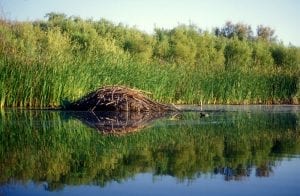Years ago, my wife and I decided to buy a lot and build a house. We chose a piece of land and hired a builder. It was exciting to watch the house’s foundation being completed and the frame of our future home being built.
God created mankind in his image with the ability to build. We have the brain capacity to learn and develop better structures. God has created other creatures with the ability to build, but that ability comes from information that God has put within them. We are going to look at a creature that God created to instinctively build particularly well.
The beaver is North America’s largest rodent, and this animal architect can alter his environment to better suit his needs.
Preparing the Area
First, the beaver can make a pond by building a dam across a stream. The backed-up water caused by the dam is affectionately called a beaver pond. A beaver dam’s average height is about 6 feet, with the depth of the water behind the dam about the same. The dam is usually is about 5 feet thick above the waterline, with the base somewhat thicker.
The beaver is completely dependent on water that is deep enough for it to swim away from a wolf, mountain lion, or bear who would love to eat him. While slow on land, the web-footed beaver can quickly swim away from anything that would prey on it.
A beaver pond also makes the beaver’s food supply of young trees reachable. Another reason the dam has to be built tall is to make the beaver pond deep enough so that the winter’s ice will not reach the bottom. This is important because the beaver stores branches under the ice for food during the winter months.
A Builder’s Tools
God has fully equipped the beaver with the right tools for its jobs, such as its webbed feet and large, flat tail. Its most essential tool is its teeth. The beaver uses its four front teeth, two on top and two below, to gnaw wood. These teeth have a hard orange coating that keeps them from chipping. Like all other rodents, the beaver’s teeth continue to grow throughout its life, and frequent gnawing wears them down.
Their gnawing ability is amazing; it takes a beaver 20 minutes to cut down a 6-inch diameter aspen tree by gnawing a widening and deepening groove around the trunk. A beaver’s jaws are so powerful they can cut through a half-inch sapling in one bite.
To make a dam, a beaver will first shove strong sticks into the stream bed. Then it pushes twigs into the gaps and piles on heavier sticks. Long poles anchor the dam to existing trees growing along the bank or to large boulders.
Then the beaver will fill the upstream side of the dam with mud, grass, or leaves to make it watertight. A beaver can carry mud by holding it against its chest and swimming to the dam using its back webbed feet to paddle. A spillway is constructed to allow overflow water to run over the dam. If the stream is too large and fast flowing, the beaver may start construction by diverting the stream to lessen the water’s flow pressure.
The length of the dam will depend on the size of the stream and the land where the pond will flood. But the average length can be anywhere from 25 to 300 feet. The longest beaver dam ever recorded is 2,140 feet long, 14 feet high, and 23 feet thick at the base.
Beavers will also vary the type of dam built and how they build it by the speed of water on the river. When the water has a more gentle flow, they will build a straight dam. But in fast-moving waters, they choose a curved dam.
Home Sweet Home
 After a dam is constructed and the water level is set, most beaver families will build a lodge in the pond. These amazing architects will construct a dome-shaped home 15 feet across with cozy hollowed-out living quarters in the center above the waterline. The lodge is built with one or two tunnel entrances opening underwater, keeping the beavers safe from predators. For fresh air and to ventilate excess heat, the beavers will put a column of loosely spaced sticks on top of the lodge.
After a dam is constructed and the water level is set, most beaver families will build a lodge in the pond. These amazing architects will construct a dome-shaped home 15 feet across with cozy hollowed-out living quarters in the center above the waterline. The lodge is built with one or two tunnel entrances opening underwater, keeping the beavers safe from predators. For fresh air and to ventilate excess heat, the beavers will put a column of loosely spaced sticks on top of the lodge.
Learned or Instinctive?
A group of scientists wanted to know if the beaver’s ability to build dams was instinctive or learned behavior. So they took a beaver raised in a zoo and put it in a fenced-in area with a stream running through it, a sunken area for a small pond to form, and all the material needed to build a beaver dam.
Can you guess what happened?
The beaver built a perfect beaver dam, proving their knowledge is instinctive. God has instilled the beaver with the knowledge of building a dam without having to be taught how. We do serve an amazing Creator God.
And God said, “Let the land produce living creatures according to their kinds; the livestock, the creatures that move along the ground, and the wild animals, each according to its kind.” And it was so. Genesis 1:24







